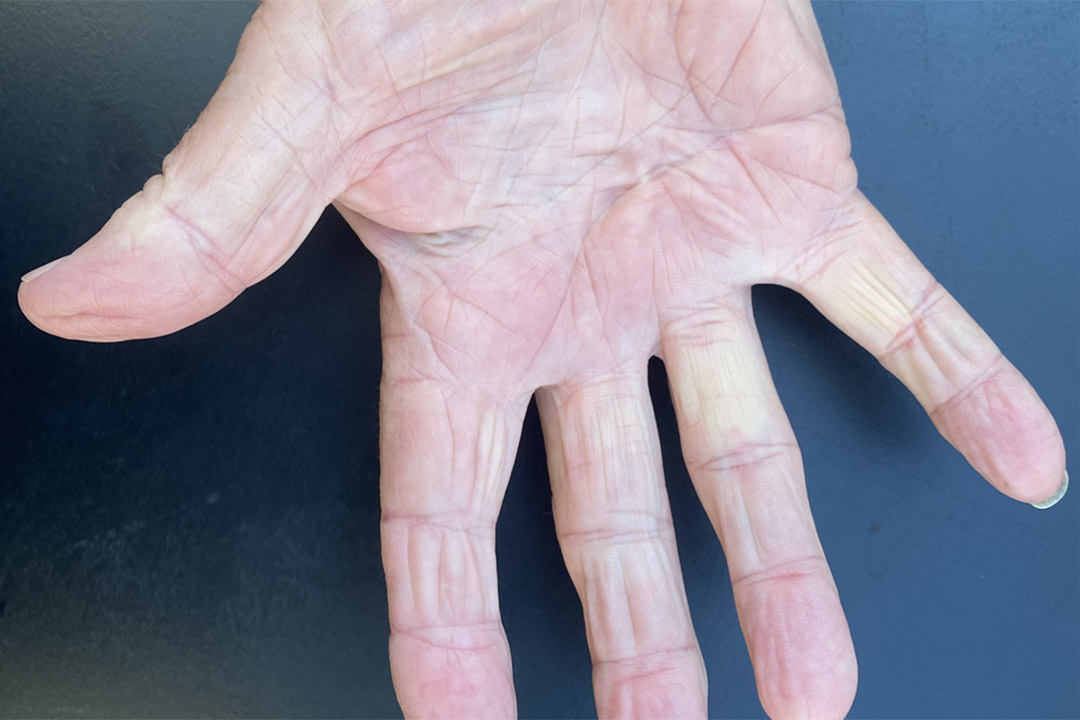
Co-authored by Dr Stephanie Mathieson
Dupuytren's (pronounced du-pwe-TRANZ) contracture is a hand deformity that usually develops over years.
It is more common in people from the north of Europe and those of Northern European descent and has been named “Viking disease” because it is more common in this population. The prevalence of diagnosed Dupuytren's disease is 1% of the population but is seven times more common in surveys asking people about their hand pain (1). The contracture is three times more likely to affect men than women, and the age of the first presentation is usually between 50 and 70 years old (2).
There is a strong genetic component to the disease, although excessive alcohol intake & trauma to the hand through injury or repetitive use may make the condition more aggressive.
The most notable symptom of Dupuytren's disease is that the tendons in the palm are prominent and rope-like. The connective tissue under the skin of the palm contracts and toughens over time. The contracture also means the fingers can curl in a resting position, and it can be challenging to make the hand lay flat. The fingers most frequently affected are the 4th and 5th fingers. A nodule or lump may be present in the hand, the palm or at the base of the fingers. Approximately 70% of people with contracture report a hard lump in one or both hands (1).
Completing daily tasks and activities can be difficult. Activities including picking up items, buttoning a shirt and putting on gloves, but people also report that their hand(s) feel weak, and hence opening jars can be difficult.
If there is no pain and the contracture has minimal impact on completing daily tasks, no treatment is needed. Unfortunately, many people receive other diagnoses when first seeing the doctor, such as rheumatoid arthritis, carpal tunnel or tendonitis (1). This can be confusing and frustrating, especially if treatment is needed but not correctly recommended.
Treatment is focused on keeping the hands mobile and stretching or breaking apart the cords pulling on the fingers and making the fingers curl. Simple analgesia and corticosteroid injections into the nodules may manage any pain. Padded gloves may help improve grip function and provide comfort in activities such as golf.
In the worst-case scenario, surgery may be needed. There are three main types of surgical procedures, but a review of randomised trials testing these techniques found that there was not enough evidence to recommend any one approach was better than the other (3). Surgery to cut part or all of the contracted cord and the surrounding tissue can lead to unintended complications, such as nerve damage creating a loss of sensation in the finger, and contracture may reoccur. Two randomised controlled trials have shown that collagenase injections are effective (the enzyme breaks down the contracted cord), but this treatment is only available in the United States of America. The product has been withdrawn from the Australian, Asian and European markets due to concerns surrounding complications.
References
1. Dibenedetti DB, et al. Prevalence, incidence, and treatments of Dupuytren's disease in the United States: results from a population-based study. Hand. 2011;6(2):149-158.
2. Karbowiak M, et al. Dupuytren’s disease BMJ. 2021;373:n1308.
3. Rodrigues JN, et al. Surgery for Dupuytren’s contracture of the fingers. Cochrane Database of Systematic Reviews. 2015;(12):CD010143.
Dr Stephanie Mathieson is a Research Fellow at the Institute for Musculoskeletal Health, University of Sydney.